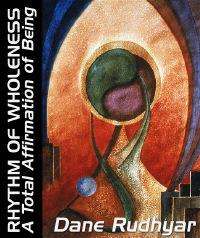 |
| Home | Bio | Art | Music | Literature | Civilization & Culture | Philosophy of Wholeness | Theosophy & Spirituality | Astrology |

RHYTHM OF WHOLENESS A Total Affirmation of Being by Dane Rudhyar, 1983 CONTENTS PROLOGUE PART ONE The Philosophy of Operative Wholeness 1. Prelude to a New Interpretation of Reality Page 1 Page 2 Page 3 Page 4 Page 5 Page 6 2. The Search for Spiritual Security: The One, the Whole, and Wholeness 3. The Movement of Wholeness PART TWO The Cycle of Being 4. The Structure of the Cycle of Being 5. The Four Crucial Phases of the Cycle of Being 6. The Inevitability of Success and Failure 7. Spirit and Mind PART THREE The Cycle of Man 8. Constitution of Man - The Physical and Psychic Bodies 9. Constitution of Man - The Spiritual Entity and the Higher Mind 10. The Structure and Transformation of the Total Person 11. The Cyclic Process of Spiritual Embodiment PART FOUR In The Spirit of Wholeness 12. The Principle of Holarchy and the Interplay of Horizontal and Vertical Relationships 13. Transpersonal Activity versus Mediumship 14. Rites of Passage EPILOGUE |

CHAPTER ONE
Prelude to a New Interpretation of Reality - 3 The individualistic approach: When a member of a primitive tribe fills an "office" — for instance, by participating in a ritual dance, wearing the mask of a vitalistic god, and feeling pervaded by the god's power — this experience does not permanently change the consciousness of the person, who afterwards assumes his or her usual life. But the possibility of wanting to retain the feeling of the experience and to build on it a "special" status is present in human nature. The person may seek to maintain his or her subjective identification with the power of the office, and this desire sets him or her apart from all other members of the tribe. Feelings of separateness and superiority develop, especially if the performance brought the performer into contact with a new or deeper level of power which produced unusual or spectacular results. The tribesman then may claim this power as characteristically and permanently "his own." He, as a "subject," possesses a unique power. He may claim this possession publicly, and the claim may be accepted by admiring members of the tribe. He is then "the one" person having such a power. But being still strongly conditioned by biological drives, he is likely to want to extend the scope of the power and to pass it to his progeny. Hereditary claim is laid, not only to the power itself, but to its possession as a social factor. More generally speaking, the feeling of being a unique individual, set apart from other persons (who are not so distinguished and do not possess the power) gives rise to the dualism of subject and object. The person as subject possesses objective, demonstrable powers; they are "his" and he can use them as he pleases. "This is my pleasure," says the chieftain, who rules "his" people and land. Soon the minds of philosophers or religious leaders feel the need to justify such a situation with the image of a personal God who possesses all imaginable powers and uses them as a "Play" (lila) to create the universe, His universe. Mind always works two ways: it interprets the results of activity, and these interpretations facilitate the spread of the activity by giving it the "sanction" of a coherent rationale. The mind performs this service by analyzing new situations to "discover" structural or essential factors ("laws"), then by deducing from these factors new ways of maximizing their power (technology). The moment a human being performs a new kind of action, feels elated by a new sense of power, and adds to the feeling of elation the thought, "This is mine, uniquely mine," the mental image of "I" arises — "I," a subject possessing a power to alter an objective world; "I," a subject owning objects that can be used, transformed, and destroyed. This realization is highly intoxicating. It is also the origin of the vast variety of conflicts inherent in most, if not all, of the systems of social organization human beings have devised, from the most capricious tyranny to the most benign democracy. It has led to the glorification of the subjective factor and devaluation of the objective world (nature). This in turn has inspired many systems of metaphysics and monotheistic religions, particularly in medieval India and Europe. These systems had to develop because they were needed to provide a foundation and justification for the slow and inherently stressful individualistic transition between the biologically dominated vitalistic type of consciousness and activity and the new (and mostly future) level of evolution which I call the Pleroma state. In India the philosophical glorification of the subjective state took various forms, some purely metaphysical (as in the Upanishads and the Advaita type of Vedanta evoked by Sri Sankaracharya), others more religious and theistic. The latter emphasizes the ubiquitous and absolute power of a God who periodically manifests in and through an objective universe, yet who also has an unmanifest and purely subjective aspect. According to the Bhagavad Gita, this God remains untouched and undiminished by his creations, but he also can intervene in the evolution of the objective universe. As (or through) an Avatar, he acts to realign the universe with its original archetypal model when centrifugal (overly individualistic) developments destructure it — that is, when the original dharma is forgotten and has to be restated and reenergized. The more strictly metaphysical systems found expression in the grand mystical statement of the Upanishads, Tat twam asi (That thou art), which proclaims the identity of the self within man (atman) and the universal Self (Brahman). But in order to understand the psychological and evolutionary function of this statement, we should consider the historical and philosophical context in which it was made. It was proclaimed by "forest philosophers," men nearing the end of lives that had been totally dominated and ritualized by the rigid imperatives of the Laws of Manu. These laws enjoined these men to prepare for death by giving up all attachments to village and kin and even to their own biological organisms. In that essentially vitalistic era, human beings considered their existence in terms of the quasi-seasonal cycle of birth-death-rebirth. The "last thought in death" (the seed-like condensation of an ending cycle of human experience) logically was believed to be the foundation out of which a future cycle of personal experience would unfold. Because yearly cycles of objective natural living follow one another endlessly, human beings too seemed forever bound to this repetitive pattern of existence. The forest philosophers, however, came to realize that a subjective center is present in human consciousness. By concentrating on this center, a person could "disobjectivize" himself and become a pure, free subject, unconditioned by nature (the gunas) and cyclic time. This was liberation (moksha) not only from biological desires and the play of the gunas in the world of nature; it also meant, at least potentially, reaching a state of inner freedom from bondage to the outer patterns imposed by Hindu society and its cults. This freedom was possible for anyone sufficiently eager to experience it through the disciplined use of meditation — that is, an inward-directed state of concentrated attention — and in general through yoga. Over the course of centuries yoga took many forms, but it aims at producing a state called kaivalya, which often is translated rather inadequately as isolation but which refers to a liberation of the individual self from the collective power of society, religion, and culture. In this sense, yoga is a way of becoming individualized. However, individualization can be achieved by fighting against the power of the collective (and of generic human nature and its impulses) or by transcending the level of being at which this power has full control of all activities and responses. This is the great issue which mankind has had to face and which it still faces today in a new and crucial way: the problem of how to become an individual free from generic nature and the collective patterns imposed by society and culture upon every newborn human being. But this "how" — the procedures and techniques used — ultimately depends upon the mental picture one makes (or is taught and impelled to make) of the state to which the process of liberation leads. The person who feels bound at first may struggle against his or her bonds, even though he or she has neither a clear picture of what produced and originally imposed such a bondage nor a positive vision of liberation. Such a struggle remains blind and totally emotional until one realizes (or is made to realize) what it is that binds and what can be expected if one wins the struggle and becomes free. To lead one to such a realization and to help the struggler imagine what will be at the end of the struggle: this is the task of the philosopher, mystic, or theologian. The mystic philosophers of the Upanishad type perhaps were dealing essentially with the universal realization, common to all human beings, of the inevitability of death. Death is not a tragedy when seen by the mind of a person belonging strictly to the vitalistic era. For such a person, birth and death are merely events inherent in all life processes. The person is such a process; he does not separate himself from it. He begins to suffer from it only when he experiences himself as a "subject" to which death happens. By proclaiming the identity of atman and Brahman, the formulation of the Upanishads simply restated the nonseparateness of a living being from the One Life, from the continuum of being and changes filling all space. Nevertheless, the restatement had to be made in different terms, because the "living being" had become the "individual self" — that is, "I" as the experiencer of the continuum of changes. Brahman, however, was not merely universal "life;" It was life beyond birth and death, a transcendent Essence. By permission of Leyla Rudhyar Hill Copyright © 1983 by Dane Rudhyar All Rights Reserved.  Web design and all data, text and graphics appearing on this site are protected by US and International Copyright and are not to be reproduced, distributed, circulated, offered for sale, or given away, in any form, by any means, electronic or conventional. See Notices for full copyright statement and conditions of use. Web design copyright © 2000-2004 by Michael R. Meyer. All Rights Reserved. |
 |